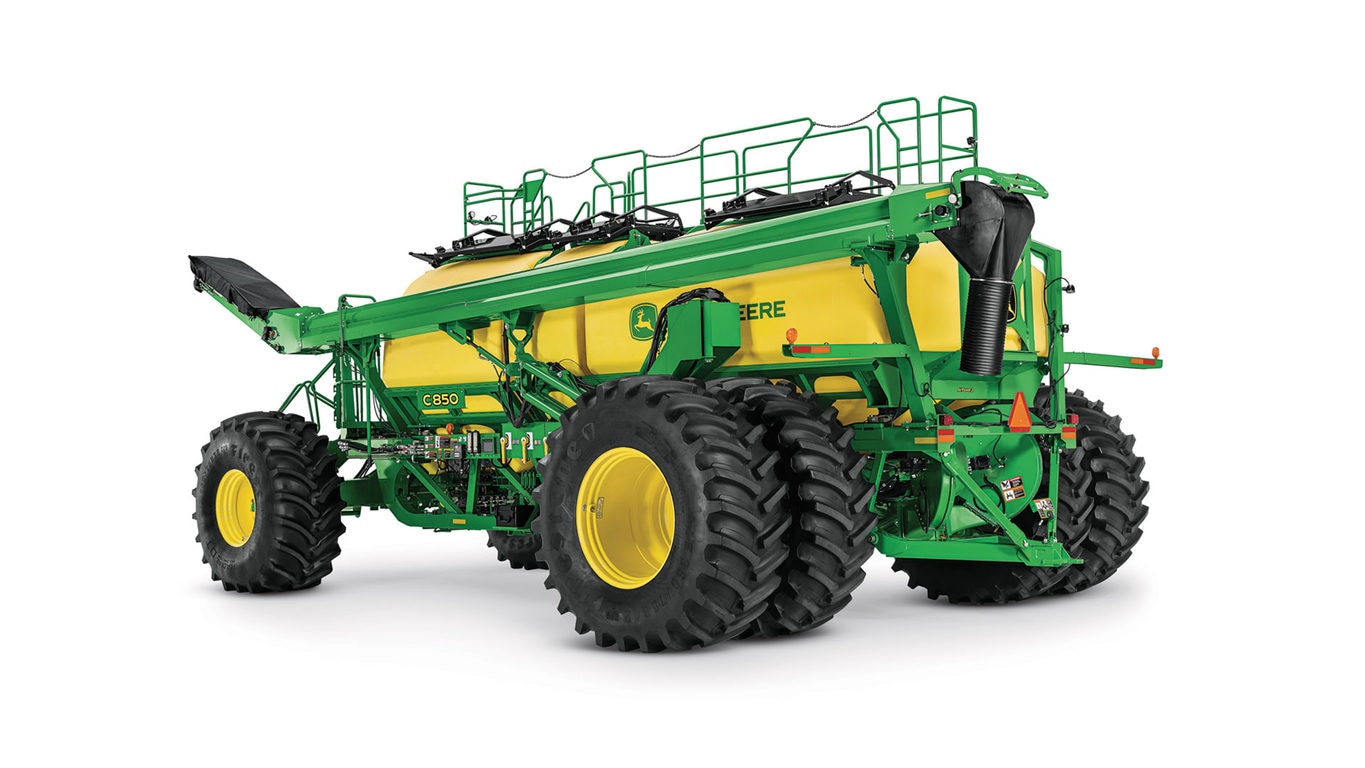
John Deere C850
Air Cart
- 850-bushel (30-cu m) capacity
- 170 acres (69 ha) per fill
- Calibrate rate in half the time
Features
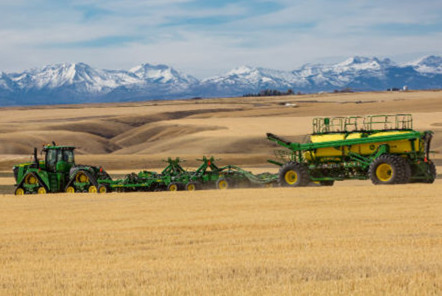
To win big in small grains, it takes a seeding solution that superseeds your expectations. John Deere delivers with a complete line of everything you need – and the sizes you want – to seed for success. Air-hoe drills. Commodity air carts. No-till air drills. Openers. Fertilizer attachments. Central commodity systems. Box drills. Plus precision ag technology to stretch your productivity to higher levels. But it’s far more than iron and technology. It’s the exceptional agronomic know-how and unsurpassed dealer support in all phases of production to keep you running. With our latest additions to equipment and openers, our seeding solutions deliver the next-generation performance you need to help you reach the full potential of each seed. That’s our commitment to you.
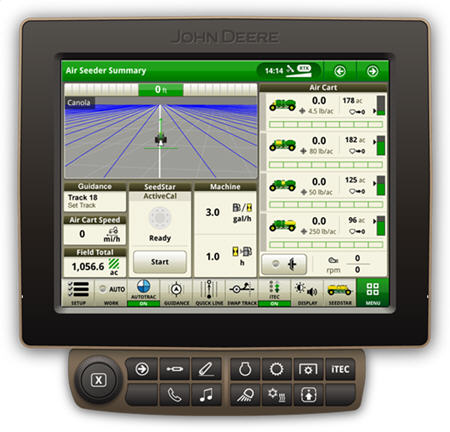 ActiveCal initiated on C-Series Air Carts
ActiveCal initiated on C-Series Air Carts
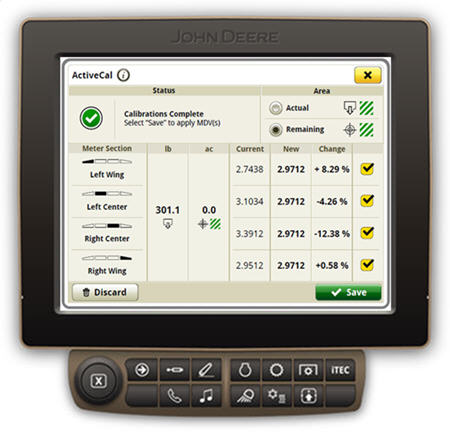 ActiveCal initiated on an N500C
ActiveCal initiated on an N500C
The more frequently you calibrate your seeding equipment, the more accurate it will be. With ActiveCal, available only from John Deere on the N500C and C-Series Air Carts, you can do all the calibration from your cab to minimize variation in product metering. It takes only minutes, so there’s no need for back-and-forth trips to the cart. ActiveCal is designed to recalibrate itself throughout your work day to give you confidence in changing product weight and weather conditions.
A number of variables, including product weight and changing climate conditions throughout the day, will have an effect on any volumetric metering system; with the John Deere ActiveCal system, calibration can be done from the cab of the tractor, while seeding, to minimize the variation in product metering.
The process to calibrate the implement starts with the Gen 4 4600 CommandCenter™ Display in the work setup page, where the operator defines product types, rates and selects meter rollers. Based on information entered into the work setup page, a preconfigured meter displacement value (MDV) will populate per meter. An initial manual calibration will give the most accurate MDV to start with. However, the preconfigured MDV will be a good starting point for growers who do not wish to manually calibrate.
The operator engages ActiveCal while stationary by selecting the button on the screen and then begins seeding. When enough product has been metered out, typically after about 3.2 to 4.9 ha (8 to 12 acres), the Gen 4 CommandCenter will prompt the operator to stop when convenient to do so. At that time, the data points are calculated and a new MDV with percent difference is displayed on screen. The operator can accept or reject the new MDV. If accepted, the system automatically calibrates to the new MDV. If rejected, the system continues at the previously calibrated numbers.
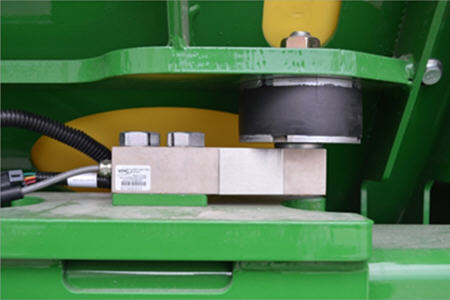 Tank scales provide tank weights to ActiveCal system
Tank scales provide tank weights to ActiveCal system
With RelativeFlow Blockage sensing, operators can see the flow of both seed and fertilizer from inside the tractor cab. Sensors on all secondary hoses monitor the relative product flow row to row, giving you a better view of the flow rate of both seed and fertilizer from the cart to the opener from inside your tractor cab. This technology can help you identify any problems before a potential blockage occurs.
RelativeFlow Blockage is available in all run configurations on the following models (all widths):
- H500
- H500F
- P500
- P600
- N500
- N500F
- N500C
- 730LL
RelativeFlow Blockage is compatible with hydraulic drive carts: model year 2014 and newer 1910, all 19,381.5-L (550-bu) 1910 Carts, and C650 and C850 Air Carts.
Below are the Gen 4 display screens for the blockage monitoring system. For complete details and information, see the owner’s manual.
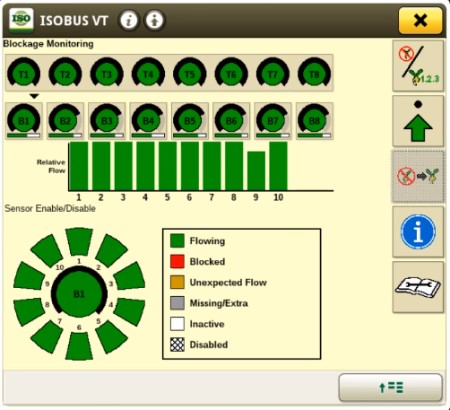 Blockage monitoring screen on Gen 4 display
Blockage monitoring screen on Gen 4 display
The RelativeFlow Blockage sensing chart shows the amount of flow through each sensor on the selected tower. Sensitivity for the blockage system can be adjusted if desired, as shown below.
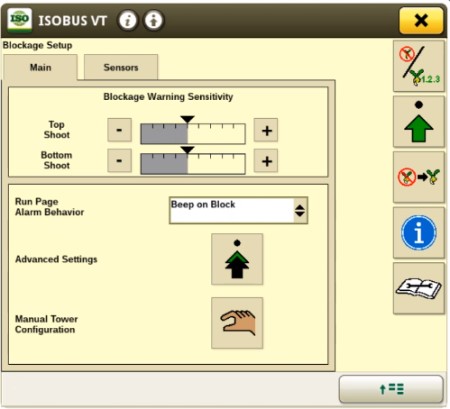 Blockage Setup screen on Gen 4 display
Blockage Setup screen on Gen 4 display
Blockage warning sensitivity allows the producer to set and change the sensitivity of the sensors to meet their preferences and varying crop/fertilizer types. Increasing the sensitivity means the system is more likely to show a false blockage, while less sensitivity means the system is more likely to miss a blockage.
Multiple run-page alarm behavior options are available for selection.
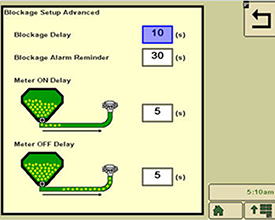 Blockage monitoring screen on Gen 4 display
Blockage monitoring screen on Gen 4 display
Below are the Gen 4 display screens for the blockage monitoring system on the N500C.
For complete details and information reference, the owner’s manual.
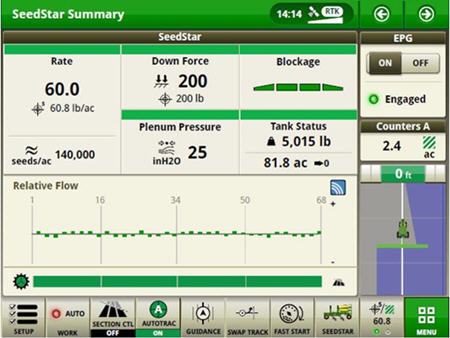 RelativeFlow Blockage configured run page
RelativeFlow Blockage configured run page
The SeedStar™ system run page displays the five major run settings. Clicking on any of the tiles will take an operator to that specific page (shown below).
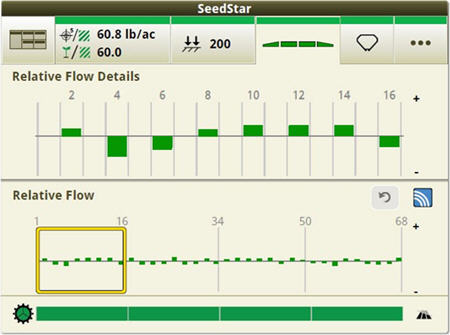 Operators can zoom into flow details by meter section when selecting blockage tiles
Operators can zoom into flow details by meter section when selecting blockage tiles
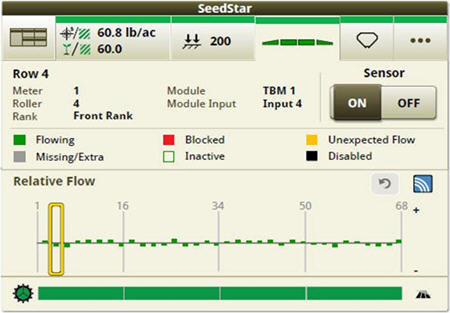 Operators can zoom into the row level to access row/sensor information and turn a sensor on/off independently
Operators can zoom into the row level to access row/sensor information and turn a sensor on/off independently
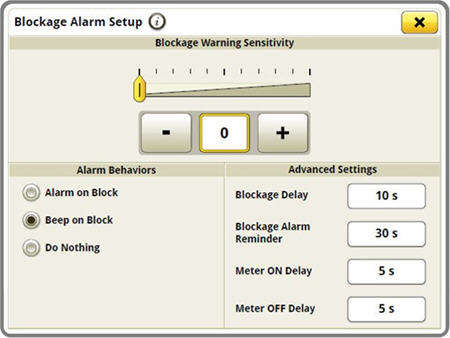 Blockage sensitivities and alarm delays are all set up on one easy-to-navigate screen
Blockage sensitivities and alarm delays are all set up on one easy-to-navigate screen
Blockage alarm delays can be set up by clicking on the advanced settings button from the blockage set-up screen.
- A blockage delay is how long a blockage should occur before an alarm is sounded.
- The blockage alarm reminder is how often the alarm should sound when a blockage occurs.
- The meter on delay is the time from when the meter is turned on until the blockage sensor should start monitoring for blockage.
- The meter off delay is the time from when the meter is turned off until the blockage sensor should start monitoring to verify no flow.
For more detailed information, see the owner’s manual.
Air tools with RelativeFlow Blockage are not compatible with 1910 air carts with ground drive.
SectionCommand is an effective, integrated, exclusive John Deere solution that reduces costly overlaps and skips that can waste seed and fertilizer, while offering more consistent fields that improve the potential of your yield and your bottom line.
Thanks to individual meter sections that control commodity flow, you can maintain the right application rates and row-to-row accuracy. This helps stimulate even crop emergence during the growing season and promotes consistent crop maturity at harvest. SectionCommand controls output from all meters on the cart up to eight sections.
Owner benefits include:
- Improved consistency of crop maturity at harvest
- Improved consistency during emergence and growing season
- Reduced seed input cost
- Reduced fertilizer input cost
- Increased time between fills due to input savings
SectionCommand is base equipment with optional deduct on all John Deere 1910 and C-Series Air Carts. Each tank and meter will receive SectionCommand components. A two-tank cart will control sections out of both tanks, a three-tank cart will control sections out of all three tanks, and the C-Series Air Carts will control sections out of all four tanks. SectionCommand is also available as an attachment for field conversion (AFC) for all 1910 hydraulic drive carts. See AFC kit story for more information.
SectionCommand controls seed and fertilizer output by closing and opening gates on the bottom side of the meter. When the gates are open, commodity is metered out, and when closed, commodity stays and continues to rotate within the meter. The meter stays full at all times so immediately when the gate opens, the commodity can flow into the primaries and out to the tool. Since each meter section has its own gate, application rates and row-to-row accuracy are not compromised. The gates are utilized to control commodity output on all sections. Once the last gate needs closed, the entire meter will stop turning, stopping product flow.
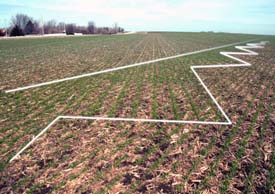 Seeded fields photo
Seeded fields photo

When commanded, electric over-hydraulic solenoids engage actuators to instantaneously close the gate for the needed section. The actuators are powered via hydraulics from the same circuit as the hydraulic drive motors. When power is cut, oil is diverted to retract the actuators and open the gates. The retraction is both powered and spring assisted, so it will always default to the seeding position. The oil from SectionCommand drains back through the fan motor case drain line and is coupled with an accumulator on the valve block to provide extra drainage capacity.
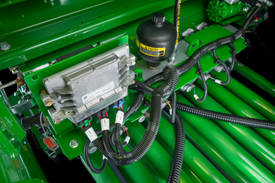 SectionCommand components as seen on back side of meter
SectionCommand components as seen on back side of meter
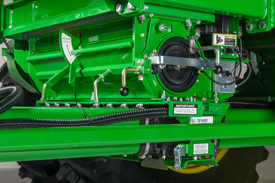 SectionCommand components as seen on front side of meter
SectionCommand components as seen on front side of meter
SectionCommand incorporates gate detection, which gives producers the satisfaction of knowing the gates are in position as commanded. Magnets on the back side of the gates are used in close proximity to the gate detection sensors to determine if the gates are open or closed. Should a gate not be in the commanded position, an alarm will alert the operator of the gate(s) in question. The blockage warning system works in conjunction with SectionCommand to give further confidence whether a given section is seeding or not when commanded.
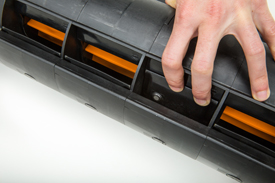 SectionCommand meter cartridge showing one gate closed and magnet on backside of gate
SectionCommand meter cartridge showing one gate closed and magnet on backside of gate
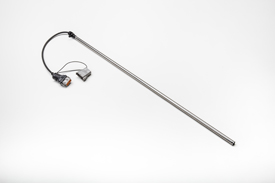 Gate detection sensor
Gate detection sensor
For maximum performance, SectionCommand should be controlled through John Deere Section Control. Coupling SectionCommand with John Deere Section Control provides the ultimate in precision seeding and productivity. If a Section Control activation is held by the producer, that same activation can be utilized for SectionCommand.
SectionCommand introduces the orange roller, which has the same number of flutes and spacing as the blue roller, but shorter flutes. It is for use only with SectionCommand when seeding seeds larger than 6 mm (0.25 in.) in diameter (soybeans, chick peas, etc.). The orange roller is not for use with cereal grains or fertilizer.
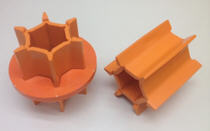 Orange roller for use only with large seeds and SectionCommand
Orange roller for use only with large seeds and SectionCommand
SectionCommand equalizer
Due to the varying lengths of product delivery hose used across the drill, SectionCommand has a built-in equalizer feature to ensure consistent product delivery across the width of the drill when entering and exiting headlands. The software allows the producer to set the on/off product delivery times separately for the outermost opener and the innermost opener on the drill. Product delivery times are inputted for each tank on the cart, and the software creates a time delay for actuation of the gates.
Please see the Using SectionCommand video for more information.
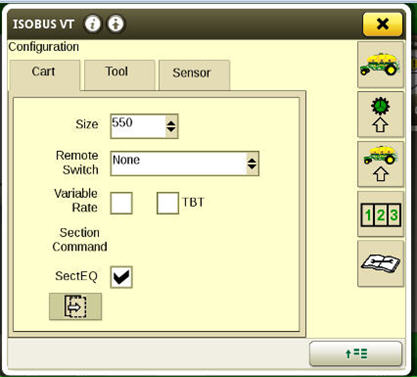 Enabling SectionCommand equalizer
Enabling SectionCommand equalizer
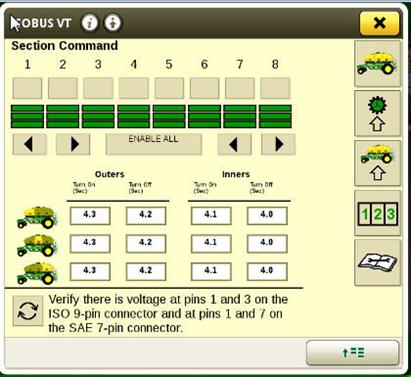 Input on/off times for outer opener versus inner opener on each tank
Input on/off times for outer opener versus inner opener on each tank
A meter cartridge at each tank effectively meters seed or fertilizer into the primary manifold. Air carries the material to the secondary distributor for delivery to the openers on the seeding tool.
Meters are contained in a cartridge for convenient removal and are color coded for easy identification.
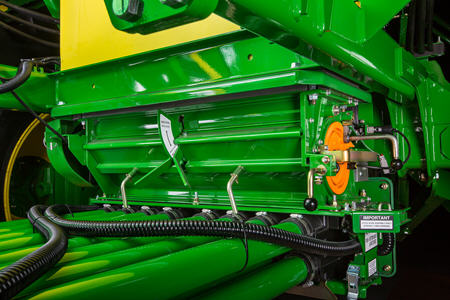 Metering system
Metering system
A manual half-width disconnect is incorporated into the meter system:
-
Allows one-half of the metering system to be manually shut off for irregular shaped headlands, point rows, etc. on mechanical drive carts.
- Allows the meter cartridge to be removed with material still in the tank(s).
- Allows tanks to be emptied with meter and primary manifold in place.
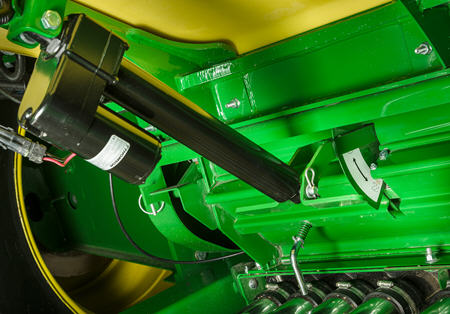 Electric actuator on C-Series Air Carts
Electric actuator on C-Series Air Carts
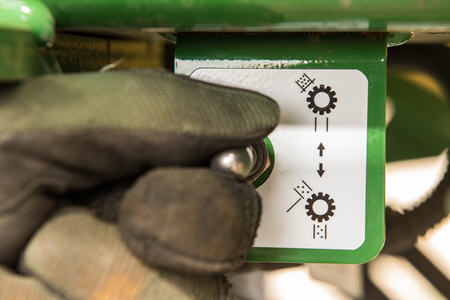
On the C-Series Air Carts, an electric actuator controls product flow from the tank to the meter housing:
- Allows complete shut off of product flow with little effort
- Allows the meter cartridge to be removed with material still in the tank(s)
- Allows tanks to be emptied with meter and primary manifold in place
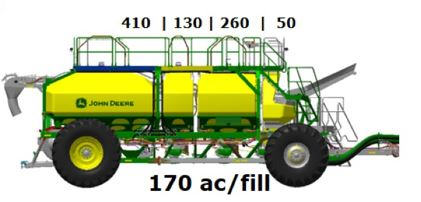 Tank capacity measured in bushels
Tank capacity measured in bushels
The total capacity of the C850 is 29,953 L (850 bu), measured by conveying product into the tank. The front tank is dedicated for low rate applications and holds 1762 L (50 bu). The remaining three tanks in order of front to rear are 9162 L (260 bu), 4581 L (130 bu), and 14,448 L (410 bu).
John Deere air cart tanks are solid molded polymer, known for superior corrosion resistance compared to steel while providing semi translucency allowing for visual verification of product level in day-time operation. Each tank is mounted in a cradle frame to eliminate interference between each other. The polymer material does not require weldments like on steel tanks. Weldments on steel tanks are prone to failure over time as the metal is fatigued under stress.
The improved top bevel design on tanks allow for greater capacity and meets the 29,953-L (850-bu) capacity without the need for shoveling product into the corners while conveyor filling.
Each tank has a wide single opening, which means it is easy for access for the conveyor and entry to the tank. Inside each tank is a ladder for cleanout access. Ladders in the tanks have been designed so that material cannot build up on steps. Top rails have been capped and sloped to ensure product sheds from the surface. When cleaning out the cart, the tanks slope steeply at bottom for product to flow easily and each tank is accessible for fill and cleanout with the conveyor.
Tanks come equipped with digital pressure sensor, ultrasonic bin level sensing, and camera-ready harnesses mounted from the factory.
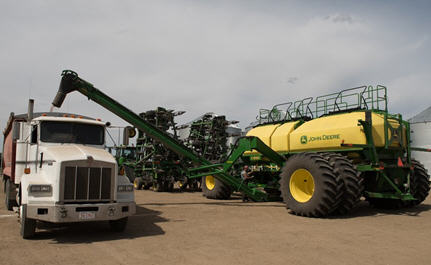 Unloading product from tanks
Unloading product from tanks
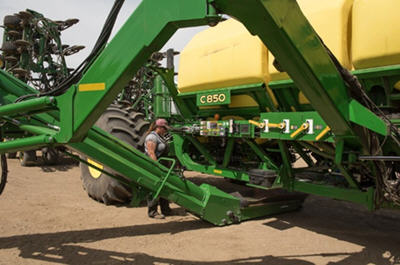 Unloading product from tanks on the C850
Unloading product from tanks on the C850
The C850 Air Cart comes standard with the wireless-controlled hydraulic conveyance system with a low-profile hopper. Maneuvering the conveyor can be done from the wireless conveyor remote or the remote tethered to the cart. With five pivot points on the arm, all tanks can be filled from one spot. The pivot points also allow the conveyor to be easily positioned and moved when filling from a seed tender.
This conveyor moves up to 3524 L (100 bu) of product in a minute with a 40.6-cm (16-in.) belt inside the 30.5-cm (12-in.) tube. By moving the hopper under meter, the conveyor can be used for clean out on each tank as well.
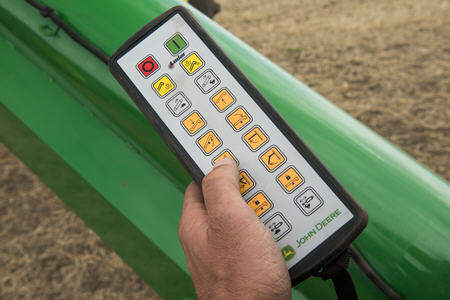 Remote to operate conveyor
Remote to operate conveyor
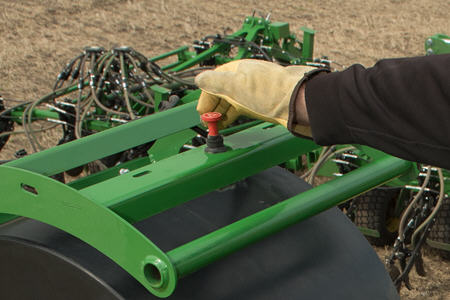 Conveyer shut off switch
Conveyer shut off switch
The shut-off switches on the conveyor are located at the bottom of the tube, above the hopper and at the top of the conveyor near the spout. Filling at night is easy with the light-emitting diode (LED) 900-lumen lights on the cart and conveyor conveniently placed to illuminate each meter, the stairway and platform.
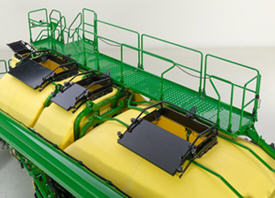 Tank lids in open position
Tank lids in open position
The C850 Air Cart has five tank lids to make filling convenient and quick. The three back tank lids are operated by pushing forward on the foot pedal and straight down on the handle. The lid slides out of the way, contouring the shape of the tank, so it does not interfere with the conveyor. The tank lids seal tight by pulling upward on the handle and stepping back on the foot pedal. The three back tank lids offer a wide opening, making an easy job out of placing the conveyor in the right place during fills. The design is a single per tank design, providing for faster fill times.
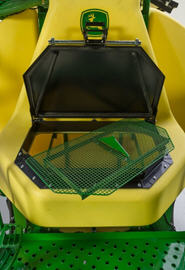 Bottom tank lid and bag splitter on front tank
Bottom tank lid and bag splitter on front tank
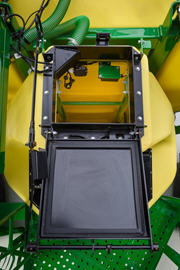 Top tank lid of front tank
Top tank lid of front tank
The front 1762-L (50-bu) tank has two options to make loading low rate products easier. If the grower is filling the tank with bags, the front lid is accessible from the lower platform of the cart. The two front railings of the cart can be removed to allow for a truck to bring bags directly to the platform. As pictured above, the bottom fill location of the front tank has a bag splitter.
To fill the front tank with a conveyor, the top tank lid is easily reached with the hydraulic conveyance system.
Specs & Compare
Key Specs | C850 Current Model |
| First tank capacity | 1762 L 50 bu |
| Second tank capacity | 9162 L 260 bu |
| Third tank capacity | 4581 L 130 bu |
| Fourth tank capacity | 14448 L 410 bu |
| Drive type | Hydraulic |
| Maximum rpm | 249.5 kg (550 lb) of seed per acre at 8.9 km/h (5.5 mph) and 15 degree slope (136.1 kg [300 lb] of fertilizer and 113.4 kg [250 lb] of seed) |
| Minimum transport width | 6.62 m 21.67 ft |
| Minimum transport height | 4.03 m 13.25 ft |
| Minimum transport length | 14.6 m 48 ft |
| Weight empty | 18552 kg 40900 lb |
Capacity | |
| Total | 29,953 L 850 bu |
Configuration | |
| Tow between | |
| Tow behind | Tow-behind only |
Tanks | |
| Type | |
| Quantity | 4 |
| First tank capacity | 1762 L 50 bu |
| Second tank capacity | 9162 L 260 bu |
| Third tank capacity | 4581 L 130 bu |
| Fourth tank capacity | 14448 L 410 bu |
| Lid size | |
| Liquid capable | |
| Liquid capacity | |
| Open lid indicators | |
| Auger | |
| Standard | |
| Optional | |
Meters | |
| Drive type | Hydraulic |
| Metering system | |
| Settings | |
| Rates | |
| Power calibration (hydraulic) | |
| Meter shutoffs | |
Monitoring | |
| Standard | |
| Optional | |
| Fan speed | |
| Ground speed | |
| Meter speed | |
| Bin levels | |
| Area covered | |
| Rate change | |
| Main clutch engagement | |
| Tank meter clutch engagement | |
| Documentation available | |
| Map-based prescriptions available | |
Fan | |
| Drive | Hydraulic |
| Maximum rpm | 249.5 kg (550 lb) of seed per acre at 8.9 km/h (5.5 mph) and 15 degree slope (136.1 kg [300 lb] of fertilizer and 113.4 kg [250 lb] of seed) |
| Hydraulic flow, maximum | |
| Standard quantity | |
| Optional quantity | |
| Diameter | 69.85 cm 27.5 in. |
| Speed range | |
Drives | |
| Type | |
| Variable-rate drive | |
| Variable-rate control | |
Front tires | |
| Standard | 800/70R38 SFT Mitas (19 psi) |
Rear tires | |
| Standard | 800/70R38 SFT Mitas (19 psi) 900/75R32 |
Dimensions | |
| Minimum transport width | 6.62 m 21.67 ft |
| Maximum transport width | |
| Minimum transport height | 4.03 m 13.25 ft |
| Maximum transport height | |
| Minimum transport length | 14.6 m 48 ft |
| Maximum transport length | |
| Weight empty | 18552 kg 40900 lb |
Additional information | |
| Date collected |
Offers & Discounts
Videos


